How To Fix a Hole In a Bathtub?
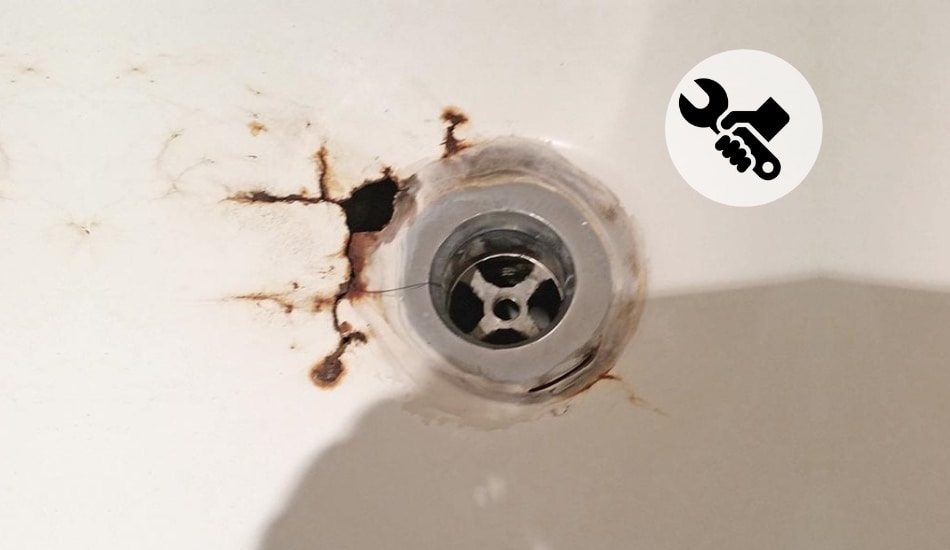
It is expected that over time, bathtubs that are made of acrylic or fiberglass will be damaged and that cracks, dents, and smaller holes will appear on them. This is a common result of long-term but also reckless use. When a person uses a bathtub, accidents can happen, such as when something very heavy suddenly falls into your fiberglass tub and damages its surface.
When the material from which the bathtub is made is found to be under excessive load, it cracks, resulting in water leakage and damage. In this article, we’ll talk about how you can fix the hole in the bathtub yourself, efficiently and economically. So, let’s start!
So How to Fix a Hole in a Bathtub? To fix a hole in a bathtub, first, you need to remove any dust (if there is one) around the hole by using a brush. Clean up all the debris that is left from the brushing. Next, use one material for patching, apply it, and let it dry. Lastly, use a porcelain repair kit and paint it over the hole.
If the hole in your bathtub is not previously fixed, then you will have a good chance to repair it. The smooth surface of the bathtub is created by the process of coating with a layer of finishing material after it is made by placing fiberglass in the mold. Gauze-like fiberglass is applied to the mold in layers that are mixed with catalyst and resin.
It is a job that is patchy and messy, and if you want the end result to be perfect, you need to do the finishing with ground and sanding. It is also recommended to additionally fasten the area under the hole if it’s possible. This procedure will further strengthen the surface and prevent the hole from re-opening. After this, the last thing you need to do is to fill in the smaller gaps inside the tub.
Two Best Ways to Fix a Hole in a Bathtub
1. Applying Fiberglass Cloth And Resin
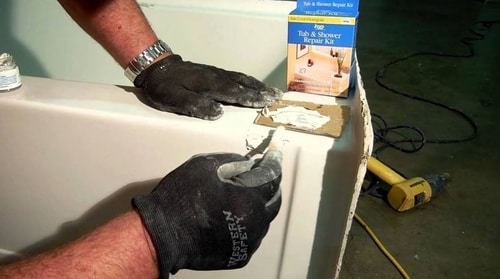
A fiberglass repair kit can be used to repair a bathtub and can be purchased at any home improvement store. When you want to repair a bathtub as quickly as possible, you will do your best by using fiberglass resin and cloth. The usual fiberglass repair kit includes a resin container, a fiberglass cloth patch, and a hardener bottle. It is necessary to add a few drops of hardener to the resin, mix them well, and then apply this mixture to the hole or crack.
Here is a step-by-step process on how to patch holes in fiberglass bathtubs:
- To eliminate contaminants, use a wire brush and remove any loosened material leftover. Then, wipe the surroundings of the bathtub with a material like lacquer thinner.
- Cut parts of oversized fiberglass cloth, leaving an extra two inches beyond the repair area.
- Blend the resin-like it’s written on the label, and then clean the bathtub surface outline with a cloth.
- Put the cloth on the patch and brush strongly with plenty of resin to soak the fabric thoroughly. Do this on multiple layers, making each layer evening previous.
- It would be great if you can do this also on the other back of the crack. With sand, you can lose higher grits until they become soft. If you want to match the hole with the existing color, be sure to paint it. Note, two-part epoxy can also be a good replacement material.
- Lastly, use bathtub refinishing material, and it will look brand new. Good refinishing material can even the oldest bathtub make look great if it is applied correctly.
Sometimes it can happen that the porcelain top coat on the tub leaks water for so long that the metal starts to lose its properties. It is the result of oxidation that is strong enough to create cracks in the bathtub.
2. Applying Epoxy and Rustoleum
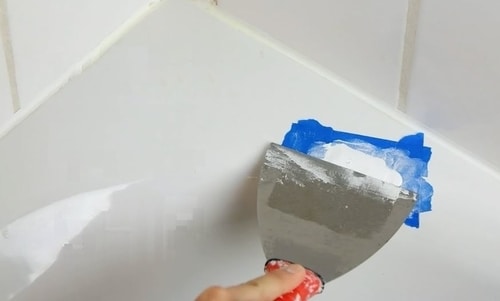
After many years of use, owners with metal bathtubs coated with porcelain enamel often find themselves in a situation where rust has bitten the porcelain finish and caused rust to appear. Therefore, it is crucial to repair the hole in the tub in this situation. Otherwise, the whole tub will be destroyed by rust.
The best way is to use an epoxy blend that fills a hole in the tub and then allows it to dry well after a couple of days. You will get a better result if you then cover the patch with a porcelain repair material. Your bathtub will look new after repair if you use tile epoxy paint or rustoleum for finishing. I used an epoxy-based product to repair dents in the tub, damaged edges, and tiles. After the work was done, the tub looked great, like new! Here are the steps that you need to follow:
- Prepare the Work Area
Before you start repairing the hole, you need to remove everything from the tub. Detach cold and hot faucet holders, the bathtub spout, the griddle and drain, escutcheon plates, and overflow. Carefully cover the floor with dropcloths. To successfully perform slicing of old bath caulking, good help is a utility blade.
It is recommended to use a putty knife or one-side cutter blade for this job. Both tools will effectively smooth out any bumps that have formed inside the tub below the nonslip strips. Note, all decorations and nonslip substrates should be removed from the tub.
- Do Safety Preparation Before the Work
Clean the tub well before you start the work. Use a coarse cloth to remove soap residue, lime scale deposits, rust residue, and bath detergents from the surface. You can use a blade razor to remove rust or old paint. Older tubs may contain lead, so be very careful not to inhale lead dust during sanding and cleaning.
It is good to use a face mask to prevent toxic substances from ending up in your body during work. This is recommended by the National Institute for Safety and Health. The tub should also be vacuumed with a powerful vacuum cleaner that has a quality filter and then wiped with a wet mop.
- Fix the Hole
How you fix the hole in your bathroom depends on the size of the hole. Smaller holes (dime-sized) are recommended to be repaired with epoxy resin in combination with hardener. Larger holes should be repaired with steel-reinforced putty epoxy, preventing the hole from reopening under higher load pressure. You can paint smaller areas with two coats of epoxy resin.
When repairing a larger hole, first measure how much putty you need, add a hardener and then stir it in until the putty reaches the right color. Shape the putty into a hole-like shape, and press it firmly into the hole. Then wait for the putty to harden, which usually takes about 90 minutes. Check the instructions that came with the product for the exact time. After drying, you can start drilling or sanding.
- Refinish the Tub
First, ventilate the entire bathroom, thoroughly clean the tub, and start sanding by using wet-dry sandpaper of 400-600 grit. Tip, if you wet sanding paper you will almost completely avoid dust formation. After you are done, sand the entire bathtub so that the new finish can grip the surface well. Pay the most attention to the sanding where the hole was formed so that spot becomes aligned with the rest of the tub.
When you are done with sanding, clean the tub again. Next, prepare the material that will be used as a top coat. Apply it to the tub with a roller, paintbrush, or paint sprayer. Leave the tub to dry for at least 36 hours, preferably 60 hours, or even longer. Exactly how long it takes to dry it is determined by the type of material you used, humidity, and heat of the room. You can find this information in the instructions for the material used.
How To Remove Hard Stains From a Fiberglass Tub?
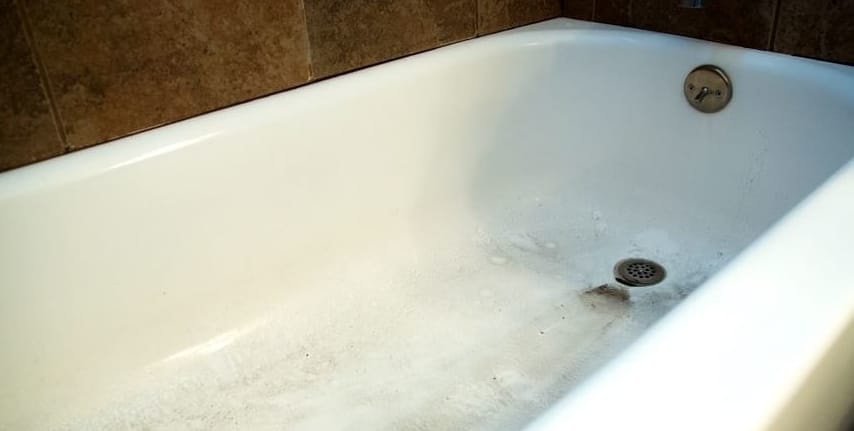
To not damage the delicate finish of the bathtub, you must carefully clean the stains on the fiberglass bathtub. We recommend covering the stain with castile soap and letting it dry for approximately one hour. Then treat the stain in a circular motion with a soft cloth.
Rinse the area very thoroughly after you’re finished. If the stain is still there, you can try to remove it with the help of baking soda and a soft cloth. But if it is a stain that cannot be removed even with the help of this product, it is time to use an acetone-based nail polish remover. Also, you can try to use turpentine. Use a sponge or damp cloth for cleaning.
Related Article: How a Bathtub Works
How to Fix a Small Hole In a Bathtub?
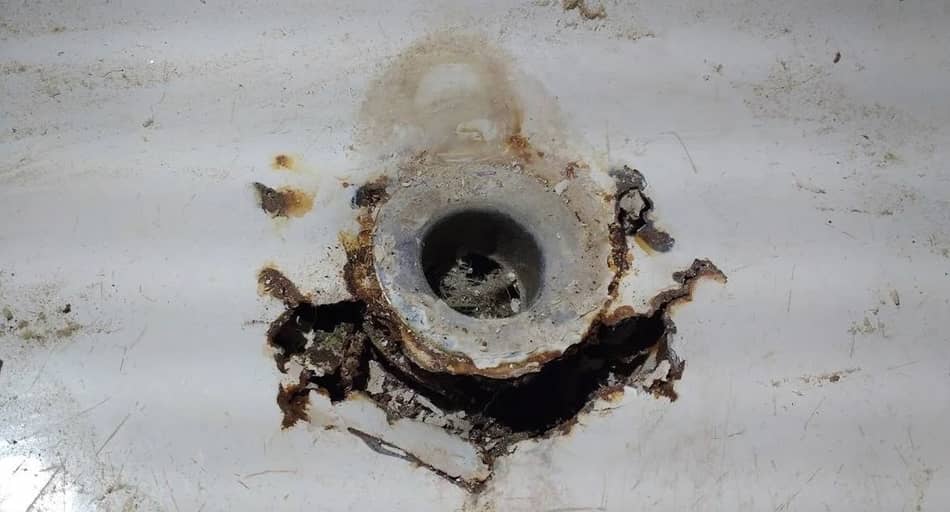
There are 2 options for fixing a small hole in your tub. Each method is good, it is up to you to decide which one is more suitable for you.
1st Method
- Cut off all the hanging edges and make it smooth by sanding.
- If the bathtub is made of fiberglass, tape the bottom off and use the Bondo Marine fiberglass kit.
- Dry it and then sand it slowly, starting from 80 grit all the way to 800 grit.
- For touch-up, use a POR 15 paint product which is made for porcelain tubs and sinks.
- Apply a small amount of automotive polish to blend it, and you will fix it quickly.
2nd Method
Cut cleanly the piece off in a square 1/4 inch around the hole, and fix it by using a fiberglass sheet. By using this method, your bathtub will look like new.
It’s a simple process. Just spread the fiberglass sheets and use the paste. Then put paint over the sheets and mold them in the shape you need. Then comes the sanding after which you should apply a little amount of waterproof sealer over the spot.
You can find these products on Amazon. Note, anything similar to this product will also work very well.
Most Common Problems With Bathtub Holes
Usually, there are the 3 most common problems that you can have with bathtub holes.
- Rusted Bathtub Drains

The most common cause of rusted holes in the bathtub are drains. In this case, it is very important to repair the hole because the rust will continue to spread if the hole is not patched. When you notice rust, you need to fix it right away! You can apply some of the methods we explained earlier in this text.
- Potential Bathtub Hole
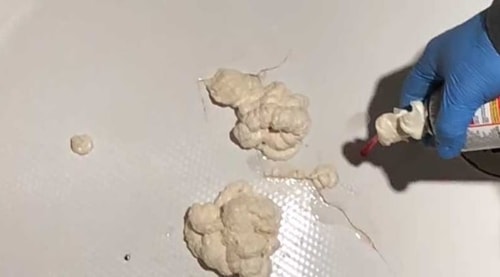
Even though there is no crack in the bathtub (yet), the metal may become so thin that it needs to be removed and fixed. These are situations that affect tubs that are not well made, especially when it comes to finishing. When making a bathtub, it is common to protect the drain from rust, which was not done in the situation described above. This fix needs to be done as soon as possible because it can be dangerous.
- Bathtub Double Rust Out
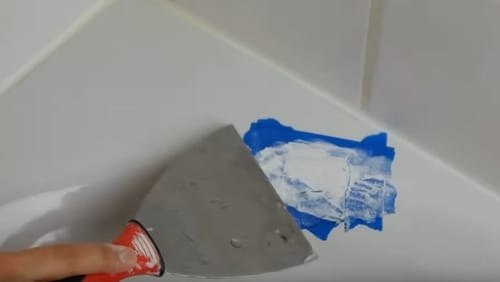
In this case, you need to completely remove all the metal that has covered the rust so that it does not reappear after the job is done. You will do this best by replacing the area around the overflow and drain with new material, preferably with fiberglass. If you are not sure how to do this, be sure to study tutorials on Youtube.
This kind of job requires knowledge, experience, and artisanship. If you can’t do the job by yourself, be sure to ask help from your experienced friends to get a good insight into who is the right person to turn to for help.
You will recognize an amateur who will not help you by the following:
- Not putting off the poor rusted metal.
- Not using fiberglass cloth to spread the opening.
- Not using strong fundamental fiberglass gel.
- Not putting fixed ring for mating on the gasket.
- Using not waterproof fill or other, skeletal in form like Bondo type.
My Example Of Fixing a Hole In The Bathtub
A few years ago, my daughter fell into a bathtub and made a hole a few inches on the side with her knee. I reacted immediately and put a temporary patch over the plastic cut. But when I started to take a shower, the patch was not strong, and water started pouring into the basement.
Then I looked for a solution and found out that there is an Acrylic Repair Kit for Bath.
- On the hole I applied the putty from underneath the bathtub. The Epoxy Putty hardens after just five minutes, but for full strength you have to wait 24 hours.
- Then I added the whole brown bottle of Part 1 to Part 2.
- I mixed the two in an aluminum dish using the rod from the kit. After I extracted the Syringe’s liquid mix.
- I used that mixed solution and with it overfilled the damaged area. Then I smoothed out air puffs with film, and let it dry for 12 to 20 hours. If you use Putty Kit and Rapid set it takes only 5 hours.
- Then I rubbed it dry and wet, and polished it to make a smooth finish.
And that was it! If you have any questions, be sure to watch this Youtube video that explains everything that you need to know how to fix a hole in a fiberglass bathtub.
Remember that the liquid obtained in the putty is almost entirely liquid acrylic, a mass that is also used when making a bathtub or obtained when a bathtub is melted. A great surprise in my case was that I found a colorless kit that helps a lot. It is a kit that corresponds to the color code IW28, also called ‘European white’. It’s a great choice for repairing 90 percent of bathtubs!
Final Thoughts
By reading this article, you could see how fixing a hole in the bathtub is not as demanding as it seems at first glance. If you use the right tools, you can easily do it yourself, which will surely save you some money. When you fix a hole in the tub, you will prevent potential damage from water leaks that can occur if you just ignore it. If you have any questions regarding repairing the hole in the bathtub, feel free to write us in the comments below.
